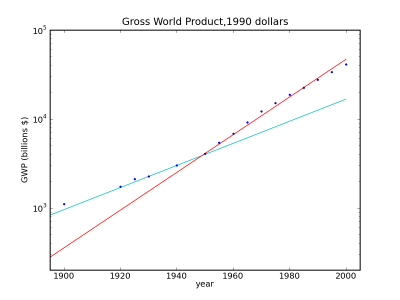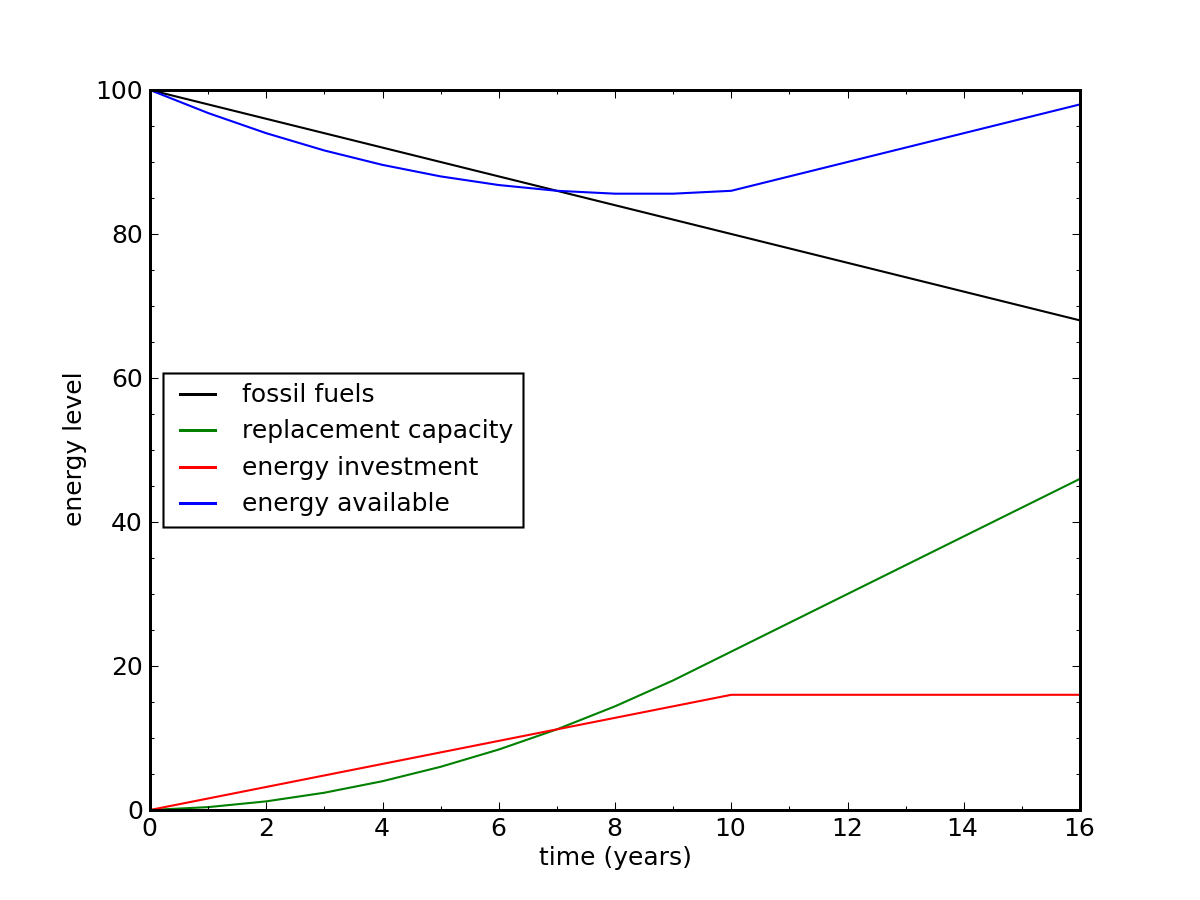The future of energy - reading notes, and discussion
This week some friends and I read and discussed 3 blog posts by physics professor Tom Murphy.
Reading #1: Galactic-scale energy
Main takeaways:
- This blog post is a thought experiment that tries to help us grasp how fast exponential functions grow by using human energy consumption as an example.
- The author says the key point is: “continued growth in energy use becomes physically impossible within conceivable timeframes.”
Summary:
- US energy consumption has been increasing 2.9% annually since 1650 (this article models it as a simple exponential function, but a follow up blog post shows that it actually is more accurately modeled by a logistic function than exponential)
- With all land covered in solar panels, we will run out of energy in 275 years. 400 if you make the model very generous. 1350 if you encircle the sun with solar panels. 2500 if you capture the energy of a large galaxy.
- This figure from the article sums it up pretty well (full size image here):

- nuclear energy doesn’t solve the problem because it heats the earth.
Thoughts:
- I wonder how a similar analysis of food or population goes? Or do we just assume those are dependent variables on energy?
- I wish he had redone the original analysis entirely using the logistic curve introduced in the follow-up blog.
- I hadn’t thought of categorizing energy this way before: “Biomass, wind, and hydroelectric … derive from the sun’s radiation, and fossil fuels represent the Earth’s batter charged by solar energy over millions of years. Only nuclear, geothermal, and tidal processes do not come from the sun”
Reading #2: Can economic growth last?
Main takeaways:
- I think his main point is that humanity will ultimately need to transition to a non-growth economy because, he argues, economic growth is bounded by energy growth.
- Humanity does not have a precedent for an effective non-growth based economy, nor a plan to successfully transition to one when it becomes necessary.
- This should be alarming.
Summary:
- The US economy and energy usage grew at same rate (2.9%) for first half of 1900s. In 1950 the economy started growing at 5% per year. Image from article (full size image here):

- Historical yearly efficiency gains: refrigerators and cars: 2%; Boeing jets: 0; coal, natural gas, nuclear: 1%
- Overall estimate: 1% per year => doubling in 70 years.
- Heat engines (mostly power plants and cars) account for two-thirds of total energy use in the US, and operate at ~35% and ~20% efficiency, respectively.
- Heat pumps (e.g., refrigerators, A/Cs) and lights can become 3x more efficient at most; cars 3.5 (by becoming electric)
- He lists ways humanity might deal with increasing economy while energy levels are flat:
- some unknown technology
- efficiency
- substitutions
- “unpyhsical” economy
Thoughts:
- I wish he had spent a little more time summarizing or discussing the steady-state economic models he mentions at the end, and the plans we could use to transition to them. What are the tools [that should be] in our toolbox? (policy? globalization?)
- I agree with his sentiment that people believe too blindly that we will be able to come up with a solution when the time comes
- He spends a lot of time defending the idea that infinite growth is infeasible. It seems so obvious that I wonder who is denying this. I would be interested in understanding why people who already believe that we are in trouble don’t act on it. Can psychology explain it?
- I would love to see a model that explored more of the middle ground scenarios (e.g. assume less than exponential growth and aggressive population control, what are the implications of his model then)?
- I’d appreciate a little more explanation and an example of how and why the economy collapses when growth wanes (he mentions the lending system is dependent on growth, but would like it spelled out).
- “Consequently, the price of food, energy, and manufacturing would drop to negligible levels relative to the fluffy stuff. And is this realistic—that a vital resource at its physical limit gets arbitrarily cheap?” – Seems more likely to me that energy will be regulated by the government and made free.
Reading #3: The energy trap
Main takeaways:
- “Nature does not provide an energy financing scheme. You can’t build a windmill on promised energy.”
- “The point is that there will always be a strong temptation to end the short-term pain for immediate relief.”
- The author is worried that when energy available from fossil fuel begins to decline, there won’t be sufficient social-economic incentives for humanity to behave rationally and spend more energy (thus speeding the decline) in order to build solutions to the problem.
Summary:
- EROEI = energy return on energy invested. Measured as out:in
- oil in early days: 100:1; oil today :20:1; oil shale: 3:1
- corn ethanol: between 1.4:1 and break-even
- coal: between 50:1 and 85:1
- solar: 10:1
- wind: 10:1
- modern nuclear: 15:1
- “In terms of accumulated energy lost, it takes 7 years before the energy sacrifice associated with replacement starts to be less than that of just following the fossil fuel slide with no attempt at replacement.” – I don’t follow the math here. The fossil-fuel slide is 2 units per year, so would take 4 years (not 7) to account for the 8 units “associated with replacement”. Or what am I missing?
- The US will need to build 60 power plants per year when we get to the state of needing to replace 3% of our fossil fuel energy per year. 1.2 per state per year.
- France built 56 reactors in 15 years: 3.73 per year
- A version where we can ramp up creation of replacement energy source (e.g., nuclear):

- “we will have to make decade-level sacrifices to put ourselves on a new track”
Thoughts:
- It seems a bit pessimistic about societies ability to rationally self-preserve. Though perhaps that is justified.
- On an individual human level, it would be like an engineer trapped with a limited amount of air and having to use it more rapidly in order to build a device that produces more breathable air. It seems obvious at the single-human or small team (or even company level), but would/could whole societies and the whole of humanity do it?
Follow up questions for the discussion
- What is your vision for humanity’s future in 100, 500, and 1000 years?
- Shift from humans living to provide (for self and family) to advancement
- Universal basic income or equivalent means a revolution in how humans spend their time. No more “work week” to pay the bills, but instead social systems focused on advancement*
- More control and understanding of body and mind? What are the major thresholds that we might reach along these paths?
- Intelligent machines have active role in society, citizenship
- What will globalization look like? Will military investments stay similar?
- End of religion, replaced by what?
- Transition to a world with no working class
- What are the most important technologies we should be researching/building today to realize that vision?
- Learning algorithms (so that we all can make more rational, informed decisions, both as individuals and societies)
- Technologies that enable and incentivize education, especially STEM since irrational human behavior is at core of many systemic issues.
- (Fermi question) How many floating point operations can we perform given the milky way’s energy budget?